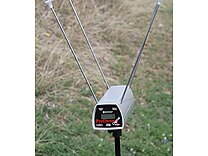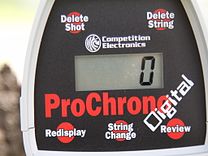Gun chronograph
A ballistic chronograph or gun chronograph is a
History
Benjamin Robins (1707–1751) invented the ballistic pendulum that measures the momentum of the projectile fired by a gun. Dividing the momentum by the projectile mass gives the velocity. Robbins published his results as New Principles of Gunnery in 1742.[1][2] The ballistic pendulum could make only one measurement per firing because the device catches the projectile.[3] The gun's accuracy also limited how far down range a measurement could be made.[4]
Alessandro Vittorio Papacino d'Antoni published results in 1765 using a wheel chronometer. This used a horizontal spinning wheel with a vertical paper mounted on the rim. The bullet was fired across the diameter of the wheel so that it pierced the paper on both sides, and the angular difference along with the rotation speed of the wheel was used to compute the bullet velocity.[5]
An early chronograph that measures velocity directly was built in 1804 by Grobert, a colonel in the French Army. This used a rapidly rotating axle with two disks mounted on it about 13 feet apart. The bullet was fired parallel to the axle, and the angular displacement of the holes in the two disks, together with the rotational speed of the axle, yielded the bullet velocity.[6]
Ingalls (1886, p. 18) describes Bashforth's chronograph that could make many measurements over long distances:
- In 1865 the Rev. Francis Bashforth, M. A., who had then been recently appointed Professor of Applied Mathematics to the advanced class of artillery officers at Woolwich, began a series of experiments for determining the resistance of the air to the motion of both spherical and oblong projectiles, which he continued from time to time until 1880. As the instruments then in use for measuring velocities were incapable of giving the times occupied by a shot in passing over a series of successive equal spaces, he began his labors by inventing and constructing a chronograph to accomplish this object, which was tried late in 1865 in Woolwich Marshes, with ten screens, and with perfect success.

The Bashforth screens were made with several threads and series connected switches. A projectile passing through a screen would break one or more threads, the broken thread caused a switch to momentarily (about 20 ms) interrupt a current as the switch arm moved from its weighted position to its unweighted position, and the momentary interruption would be recorded on a paper chart.[7]
The first electronic ballistic chronograph was invented by Kiryako ("Jerry") Arvanetakis in the 1950s.[
Modern chronograph
The modern chronograph consists of two sensing areas framed by rods topped by diffusing screens or artificial lighting above (or below) along with optical sensors that detect the passage of the bullet. The time it takes the bullet to travel the distance between the sensors is measured electronically from which velocity is calculated and displayed.
Advanced ballistic chronographs include a type employing Doppler radar to measure bullets in free flight at various distances; another is a device mounted at the end of a barrel, which uses magnetic field sensors for the measurement of a bullet's velocity as it exits the muzzle.[8]
See also
References
- ^ Ingalls 1886, p. 17
- ^ Robins, Benjamin (1805), New Principles of Gunnery (New ed.), F. Wingrave
- ^ Bashforth 1866, p. 3, "only one observation on each round".
- ^ Bashforth 1866, p. 3, "Beyond 295 feet the gun was not sufficiently accurate".
- ^ d'Antoni, Alessandro Vittorio Papacino (1765), Esame Della Polvere, Torino: Nella Stamperia Reale
- ^ Prony (1805), "Report of a method of measuring the initial Velocity of Projectiles discharged from Fire-arms, both horizontally and with different Elevations, made to the Physical and Mathematical Class of the National Institute", in Nicholson, William (ed.), A Journal of Natural Philosophy, Chemistry and the Arts, vol. XI, London at page 42
abridged from Journal des Mines No 92 p. 117, May 1804. - ^ Bashforth 1866, pp. 12–13
- ^ "15 Best Shooting Chronographs". 22 November 2020.
- Bashforth, Francis (1866), Description of a Chronograph adapted for measuring the varying velocity of a body in motion through the air and for other purposes, London: Bell and Daldy
- Ingalls, James M. (1886), Exterior Ballistics in the Plane of Fire, New York: D. van Nostrand
Further reading
- Bashforth, Francis (1873), A mathematical treatise on the motion of Projectiles founded chiefly on the results of experiments made with the author's chronograph, London: Asher and Company
- Bashforth, Francis (1907), Ballistic experiments from 1864 to 1880, Cambridge University Press
- Bashforth, Francis (1890), Revised account of the experiments made with the Bashforth Chronograph, to find the resistance of the air to the motion of projectiles, with the application of the results to the calculation of trajectories according to J. Bernoulli's method, Cambridge University Press
- Bashforth, Francis (1903), A Historical Sketch of the Experimental Determination of the Resistance of the Air to the Motion of Projectiles, Cambridge University Press


